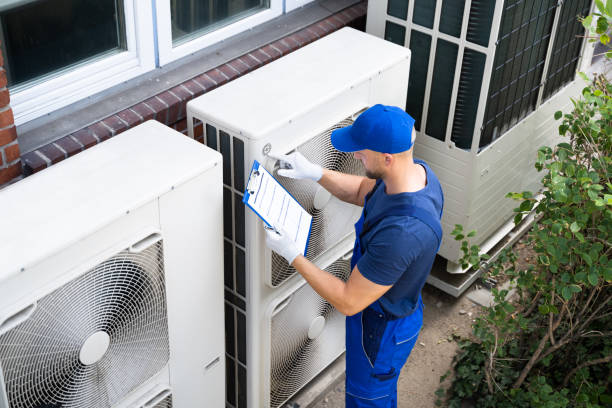Spring HVAC Maintenance Checklist: Your Complete Guide
As winter fades and spring approaches, your spring HVAC maintenance checklist becomes crucial for ensuring optimal comfort and energy efficiency throughout the warmer months. A comprehensive spring HVAC maintenance routine not only extends your system’s lifespan but also prevents costly repairs and reduces energy costs. This detailed HVAC maintenance checklist will guide you through essential spring maintenance tasks, helping you prepare your heating and cooling systems for peak performance.
Spring HVAC maintenance is more than just a seasonal routine—it’s an investment in your home’s comfort, your family’s health through improved indoor air quality, and your wallet through enhanced energy efficiency. Whether you’re maintaining your air conditioning unit, heating system, or complete HVAC system, this maintenance checklist ensures you don’t miss critical components that could impact your system’s performance.
Why Your Spring HVAC Maintenance Checklist Matters

Your spring HVAC maintenance checklist serves as the foundation for year-round system reliability. During winter months, your heating system works overtime, while your air conditioning components sit dormant. Spring maintenance bridges this transition, ensuring both your heating and cooling systems are ready for their respective seasons. Proper HVAC maintenance significantly impacts your home’s energy efficiency, potentially reducing energy costs by 15-20% annually according to Energy Sta rmaintenance guidelines.
Indoor air quality depends heavily on your HVAC maintenance routine. Clean air filters, properly functioning ventilation, and well-maintained ductwork ensure your family breathes cleaner, healthier air. Your spring HVAC maintenance checklist addresses these critical components, creating a healthier home environment while optimizing system performance for the upcoming cooling season.
1. Essential Air Filter Maintenance for Spring
Air filters represent the most critical component in your spring HVAC maintenance checklist. These filters protect your HVAC system while maintaining indoor air quality throughout your home. During spring maintenance, inspect all air filters in your heating and cooling systems, replacing them according to manufacturer recommendations. Your HVAC maintenance routine should include checking air filters monthly, especially during peak usage seasons.
Air Filter Maintenance Tasks:
- Monthly inspection – Check all air filters for dirt, dust, and debris accumulation during your HVAC maintenance routine
- Proper sizing – Ensure filters fit correctly without gaps that allow unfiltered air to bypass the filtration system
- MERV rating selection – Choose appropriate efficiency ratings (MERV 8-12 for most residential HVAC systems) to balance filtration and airflow
- Replacement scheduling – Replace standard filters every 1-3 months, high-efficiency filters every 6-12 months, depending on usage
- Multiple filter locations – Check filters in your heating system, air conditioning unit, and any additional air handlers throughout your home
Dirty or clogged air filters restrict proper airflow, forcing your HVAC system to work harder and consume more energy. This increased workload leads to higher energy costs and accelerated wear on moving parts within your system. Consider upgrading to smart filters that monitor air quality and send replacement reminders as part of your comprehensive spring HVAC maintenance checklist.
2. Outdoor Unit Inspection and Cleaning
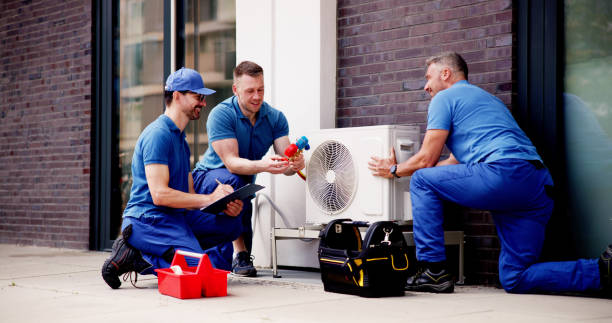
Your outdoor unit requires thorough attention during spring HVAC maintenance to ensure optimal cooling performance. Winter weather can deposit leaves, debris, dirt, and other contaminants around and inside your outdoor unit, restricting airflow and reducing efficiency. Begin your outdoor unit maintenance by turning off the power at both the unit and the electrical panel. Remove any debris, leaves, or vegetation within two feet of the unit.
Clean the condenser coils using a soft brush or vacuum to remove accumulated dirt and debris. Dirty coils force your air conditioning system to work harder, increasing energy consumption and reducing cooling efficiency. Inspect the outdoor unit’s electrical connections for signs of corrosion, loose wires, or damage. Check that the unit sits level and secure on its pad to prevent unnecessary vibration or noise.
3. Heating System Spring Maintenance Tasks
Even though spring signals the end of heating season, your heating system requires attention in your spring HVAC maintenance checklist. Post-season maintenance prevents issues from developing during the system’s dormant period and ensures readiness for next winter. Inspect your heating system’s components, including the heat exchanger, burners, and venting systems. Look for signs of wear, corrosion, or damage that may have developed during heavy winter usage.
Check your heating system’s pilot light or ignition system to ensure proper function. For homes with boilers or radiant heating systems, inspect pipes, connections, and circulation pumps. Your spring HVAC maintenance should address any heating system issues before they become major problems. If issues are discovered, heating repair services can address problems promptly. Consider heating maintenance services for comprehensive system evaluation and professional care.
4. Air Conditioning System Preparation
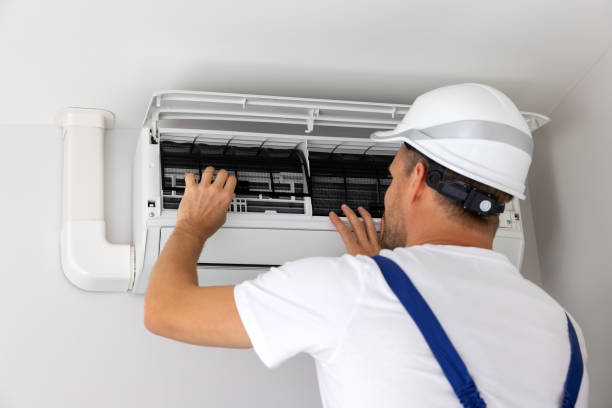
Preparing your air conditioning system is a critical component of your spring HVAC maintenance checklist. After months of dormancy, your AC unit requires a thorough inspection and preparation before the cooling season begins. Start your air conditioning preparation by testing your air conditioner’s operation, switching to cooling mode, and allowing the system to run through a complete cycle.
Listen for unusual noises, observe whether the system achieves desired temperatures, and ensure proper airflow through all vents. Inspect your AC unit’s condensate drain to prevent water damage and humidity problems. Clear any blockages and ensure proper drainage away from your home’s foundation.
A clogged condensate drain can cause water backup, potentially damaging your system and home. Professional AC maintenance, can address refrigerant levels and complex system diagnostics. If your system requires repairs after testing, AC repair services can restore optimal cooling performance.
5. Thermostat Calibration and Smart Technology
Your thermostat serves as the command center for your HVAC system, making its proper operation essential for energy efficiency and comfort. Include thermostat evaluation in your spring HVAC maintenance checklist to ensure accurate temperature control and optimal system performance. Test your thermostat’s accuracy by comparing its reading to a separate, calibrated thermometer placed nearby.
Clean your thermostat’s interior components if you have an older mechanical model, and replace batteries in digital thermostats. Consider upgrading to a smart thermostat during your spring HVAC maintenance routine. Smart thermostats learn your preferences, adjust automatically for energy efficiency, and allow remote control, potentially reducing energy costs by optimizing heating and cooling cycles based on occupancy and weather patterns.
6. Ductwork and Airflow Optimization
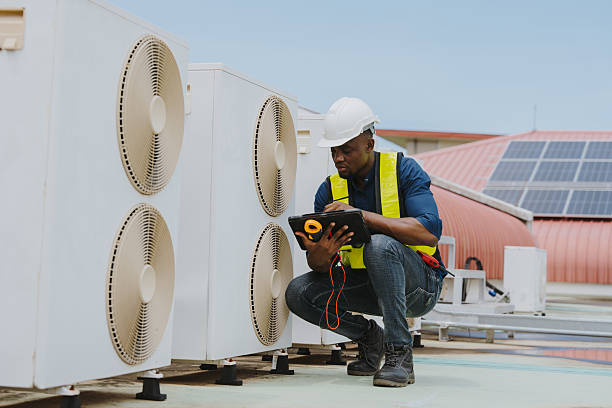
Proper airflow throughout your home depends on well-maintained ductwork, making duct inspection an essential element of your spring HVAC maintenance checklist. Damaged, disconnected, or leaky ducts can significantly impact your system’s efficiency and indoor air quality. Inspect visible ductwork for signs of damage, disconnections, or excessive dust accumulation. Look for gaps in duct joints, damaged insulation, or sections that may have shifted during winter. Understanding proper HVAC ductwork installation helps homeowners identify potential issues during maintenance.
Check that all supply and return vents remain unobstructed by furniture, curtains, or other items. Blocked vents disrupt proper airflow and can cause pressure imbalances within your HVAC system. Consider professional duct cleaning if you notice excessive dust, pet dander, or other contaminants, especially if family members suffer from allergies or respiratory issues. The EPA provides guidelines on air duct cleaning to help homeowners make informed decisions about professional services.
7. Electrical Connections and Safety Checks
Electrical connections throughout your HVAC system require careful inspection during spring HVAC maintenance to ensure safe, reliable operation. Loose, corroded, or damaged electrical components can cause system failures, increased energy consumption, or safety hazards. Turn off the power to your HVAC system before inspecting any electrical connections. Check connections at your outdoor unit, indoor air handler, and electrical panel.
Inspect electrical wiring for damage from pests, weather, or general wear. Rodents sometimes damage HVAC wiring during the winter months when seeking shelter. Test your system’s electrical safety features, including disconnect switches and circuit breakers. These components protect your HVAC system and home from electrical problems.
8. Professional HVAC System Tune-Up Benefits
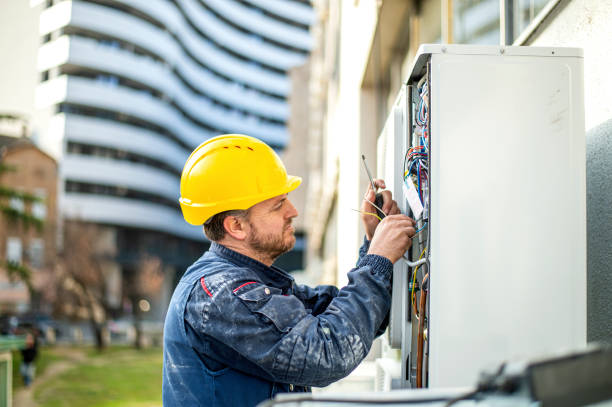
While DIY maintenance handles many spring HVAC maintenance checklist items, professional tune-ups provide comprehensive system evaluation and service beyond typical homeowner capabilities. Professional technicians have specialized tools, training, and experience to identify potential problems before they cause failures. Many HVAC manufacturers require professional maintenance to maintain equipment warranties.
Professional HVAC Maintenance Services Include:
- Refrigerant level testing and adjustment – Ensures optimal cooling performance and prevents compressor damage in your air conditioning system
- Electrical system comprehensive testing – Verifies that all electrical connections, capacitors, and controls operate safely and efficiently.
- Motor lubrication and inspection – Maintains moving parts to prevent premature wear and reduce energy consumption
- System calibration and controls testing – Ensures thermostats, sensors, and automated controls function accurately for optimal comfort
- Deep coil cleaning services – Remove built-up dirt and debris from condenser and evaporator coils using specialized equipment
- Comprehensive safety inspection – Identifies potential hazards, carbon monoxide risks, and code compliance issues
Professional maintenance includes cleaning tasks that require specialized equipment and performance optimization adjustments. For comprehensive residential HVAC services and expert system tune-ups, professional technicians can address complex maintenance needs beyond typical homeowner capabilities. For reliable HVAC services, experienced professionals ensure your system operates at peak efficiency throughout the year.
9. Energy Efficiency and Indoor Air Quality
Energy efficiency improvements should be central to your spring HVAC maintenance checklist, as they provide ongoing benefits through reduced energy costs and improved comfort. Simple efficiency upgrades can significantly impact your system’s performance and operating expenses. Examine your home’s insulation and air sealing to reduce heating and cooling loads on your HVAC system. Consider system age when planning efficiency improvements, as understanding how long HVAC systems last helps determine whether maintenance or replacement provides better value.
Indoor air quality directly impacts your family’s health and comfort, making it an essential consideration in your spring HVAC checklist. Evaluate your home’s ventilation to ensure adequate fresh air exchange and monitor humidity levels throughout your home. Consider adding air purification systems to your HVAC system during spring maintenance for significantly improved indoor air quality. For older systems requiring replacement, professional AC installation, ensures optimal performance and efficiency.
10. Seasonal Transition Planning and Timeline
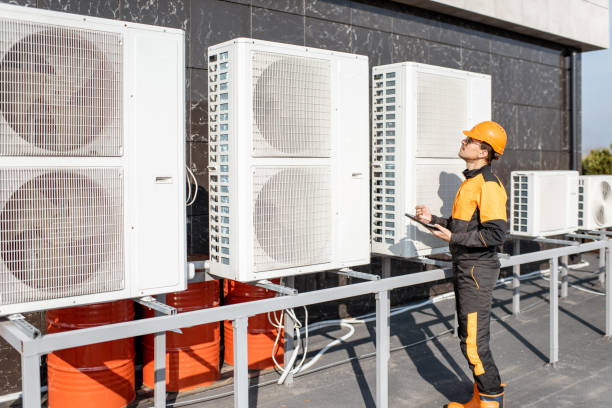
Spring represents a transitional period requiring specific attention in your HVAC maintenance routine. Your system must shift from heating mode to cooling mode, requiring adjustments and preparations for changing weather patterns and comfort needs. Program your thermostat for spring and summer temperature preferences, taking advantage of milder weather to reduce energy consumption.
Spring HVAC Maintenance Timeline and Tasks
| Timing | Maintenance Task | System Component | Expected Outcome |
| Early March | Replace air filters and inspect ductwork | Heating and cooling systems | Improved indoor air quality and proper airflow |
| Mid-March | Clean outdoor unit and remove winter debris | Air conditioning outdoor unit | Enhanced cooling efficiency and airflow |
| Late March | Test heating system operation and safety features | Heating system components | Verified heating readiness for next season |
| Early April | Inspect electrical connections and calibrate the thermostat | Electrical systems and controls | Safe, efficient system operation |
| Mid-April | Test air conditioning operation and refrigerant levels | Cooling system components | Optimal cooling performance for summer |
| Late April | Schedule a professional tune-up and system inspection | Complete HVAC system | Comprehensive maintenance and warranty compliance |
| Early May | Optimize energy efficiency settings and smart controls | Automation and control systems | Reduced energy costs and enhanced comfort |
Prepare your home for increased humidity and potential storm activity during the spring months. Plan for increased system usage as temperatures rise, ensuring your air conditioning components are ready for peak cooling season. For businesses requiring commercial HVAC service, professional maintenance becomes even more critical for operational continuity.
11. Cost-Effective Maintenance and Record Keeping
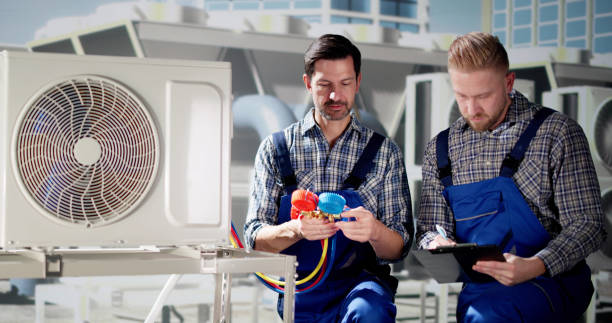
Implementing a thorough spring HVAC maintenance checklist provides excellent return on investment through reduced energy costs, prevented repairs, and extended equipment life. Focus on high-impact, cost-effective maintenance tasks that provide maximum benefit for your investment. Regular filter changes represent the most cost-effective maintenance task, providing significant benefits for minimal expense. The Department of Energy offers maintenance tips that complement your spring maintenance routine for optimal system performance.
Documenting your spring HVAC maintenance activities provides valuable information for future maintenance planning, warranty claims, and system troubleshooting. Maintain detailed records of all maintenance tasks, repairs, and system performance observations. Record dates and details of filter changes, cleaning activities, and any issues discovered during maintenance to help identify patterns and track component life.
In Summary
A comprehensive spring HVAC maintenance checklist is essential for ensuring optimal comfort, energy efficiency, and system reliability throughout the year. By following these detailed maintenance guidelines, you protect your investment, reduce energy costs, and maintain healthy indoor air quality for your family. Regular spring HVAC maintenance prevents costly repairs, extends equipment life, and ensures your HVAC system performs efficiently when you need it most.
Don’t let seasonal transitions catch you unprepared—take action now to implement your spring HVAC maintenance routine. For professional assistance with complex maintenance tasks or to schedule comprehensive system service, contact Callidus Air today. Our experienced technicians through Callidus Air can help you maintain peak HVAC performance and ensure your home remains comfortable throughout every season.
Frequently Asked Questions
How often should I perform spring HVAC maintenance?
You should complete your spring HVAC maintenance checklist annually, typically in early spring before the cooling season begins. However, some tasks like air filter changes should be performed monthly or quarterly, depending on your system and home conditions.
Can I perform all spring HVAC maintenance tasks myself?
While many spring HVAC maintenance tasks can be performed by homeowners, some require professional expertise for safety and warranty reasons. Tasks involving refrigerant, electrical work, or gas connections should always be handled by qualified technicians.
What’s the most important item on a spring HVAC maintenance checklist?
Air filter replacement is typically the most critical and cost-effective maintenance task. Clean filters improve indoor air quality, protect your HVAC system, and maintain energy efficiency throughout the cooling season.
How much can proper spring HVAC maintenance save on energy costs?
Well-maintained HVAC systems can reduce energy consumption by 15-20% compared to neglected systems. Regular spring HVAC maintenance optimizes efficiency and prevents energy waste from dirty filters, blocked airflow, and poorly maintained components.
When should I schedule professional HVAC service as part of my spring maintenance?
Schedule professional HVAC service in early spring, before peak cooling season demand increases. Professional maintenance should complement your DIY spring HVAC maintenance checklist for comprehensive system care and optimal performance.

